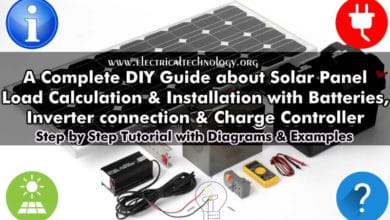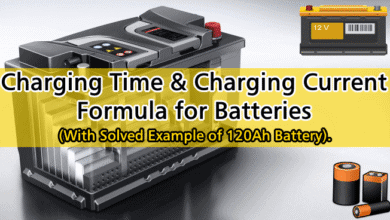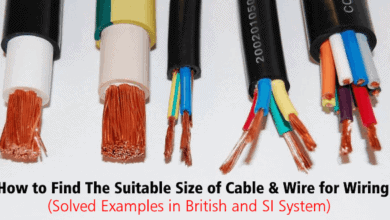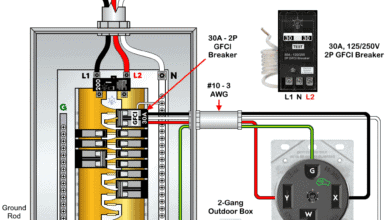Part 11 – Sizing Disconnecting Means for Motor & Controller
How to Size Disconnecting Switch, Fuse & Breaker for Motors and Controllers
Disconnecting Means for Motors & Controllers
Although we know that the motor disconnecting means can be sized based on the full load current using NEC Tables 430.247, 430.248, 430.249, and 430.250. The similar approach is used to size the motor’s conductors, short-circuit, and ground-fault protection. Aside from the similarity, the NEC has specific requirements for sizing, selecting, and installing disconnects for motor circuits.
Each motor and motor controller must have a disconnect switch within sight of the motor and its controller, respectively – 430.101 & 430.75(A). If the controller’s disconnect is within sight of the motor, it can also serve as the disconnect for the motor (430.102(B)). Additionally, both the motor and motor controller must be easily accessible (430.102 & 430.107).
The disconnecting means should be within sight of the motor. If the disconnecting means is not within sight of a motor rated at 1,000V or less, a second disconnecting means is required within 50 feet (15 m) and within sight of the motor, with a lockable feature – 430.102(B)(1).
According to 430.110, one of the following seven types of disconnects listed in 430.109(A)(1) through (7) can be used for a motor or motor controller (starter/contactor):
- Motor-circuit switch rated in HP
- Molded-case circuit breakers
- Molded-case switches
- Instantaneous-trip circuit breaker
- Self-protected combination motor controller
- Manual motor controller (fuses, HP-rated plug and receptacle)
- System isolation equipment
For stationary motors rated 1⁄8 HP or less, the branch circuit overcurrent protective devices (OCPDs) is permitted to be used as the disconnecting means (430.109(B)).
As per 430.109(C), if a stationary motor is rated 2 HP or less and operates at 300V or less, one of the following can serve as a disconnect for the motor circuit:
- A general-use AC snap switch (not a DC or AC-DC switch) with an ampere rating of at least twice the motor’s full-load current (FLC).
- The motor’s FLC must not exceed 80% of the switch’s ampere rating. In other words, the switch’s ampere rating must be at least 125% of the motor’s FLC, as listed in Tables 430.247 through 430.250. – 480.83(C)(2)
- A listed manual motor controller, marked “suitable for motor disconnect,” with an HP rating not less than the motor’s HP.
According to 430.109(F), additional disconnecting means (such as a plug and receptacle, cord connector, or flanged surface inlet) can be used as a motor disconnect if they are HP-rated, meaning their rating must be at least equal to the motor’s HP.
As per 430.110:
- The current rating and interrupting capacity of the disconnecting means for single motor shall be at least 115% of the full-load current (FLC) of the motor circuit rated for 1,000V nominal or less. This rule does not apply to a listed unfused motor-circuit switch with a horsepower (HP) rating equal to the motor HP – 430.110(A).
- For torque motors, the disconnecting means shall have a rating of 115% of the nameplate full-load amperes (FLA) – 430.110(B).
- For two or more motors, or a combination of a motor and other loads controlled by a single disconnecting means, the current and horsepower ratings of the combined load shall be determined in accordance with 430.110(C)(1), (2), and (3).
The controller disconnect can also serve as the disconnect for the control circuit conductors if the control circuit conductors are tapped from it (430.102(A)). However, if the control circuit conductors are not tapped from the controller disconnect and are instead supplied by a Class 1 control circuit, a separate disconnect must be installed adjacent to the controller disconnect.
Motor controllers can include molded-case circuit breakers, molded-case switches e.g. contactors, and starters with overload relays (430.83(A)). Any other device used as a motor controller must have an HP rating equal and suitable for the specific motor.
If a general-use snap switch is used as a motor controller, the motor controller’s ampere rating must not exceed 80% of the switch’s ampere rating. In other words, the switch’s ampere rating must be at least 125% of the motor’s full-load current (FLC).
The ampere rating of a general-use switch used as a controller shall be at least twice the full-load amperes (FLA) of stationary motors rated at 2 HP and 300V or less – 430.83(C).
The continuous-duty, full-load current rating of the motor controller shall be at least equal to the nameplate full-load amperes (FLA) of the motor. If the FLA is not marked, the equivalent current rating should be determined using the horsepower (HP) values listed in Tables 430.247 through 430.250. – 430.83(D).
How to Size Disconnects and Switches for Motor and Controller
When selecting disconnects and switches for motors and controllers, you must consider factors such as the full-load current (FLC) of the motor, the type of disconnecting means, and compliance with NEC 2023 regulations.
The switch use as disconnect must be rated for the motor’s operating voltage and be capable of safely handling short-circuit, overcurrent, and overload protection and associated currents in accordance with NEC 430.52 for circuit breakers or fuses.
Example 1: Sizing Disconnecting Means For a Motor
What is the suitable size of disconnecting means in HP to disconnect the three-phase, 460V, 25 HP Motor?
Solution:
As the rating of disconnect switch for 3-phase motor is required in HP, Hence, according to the 430.109(A)(1).
The rating of disconnect shall equal to 25 HP.
Example 2: Sizing Fuse & Circuit Breaker as Disconnecting Means for Motors
What is the suitable size of fuse and circuit breaker for 30HP, 460V, 3-phase motor
Solution:
Determine the full load current (FLC) for 30HP, 460V, 3-phase motor using Table 430.250.
40A
Fuse Size Selection:
Refer to the Table 430.52(C)(1) to find the multiplier value for dual element (time delay) and non-time delay fuse. Multiply the it with FLC.
FLC × Value of Multiplier
- Non-Time Delay Fuse
40A × 300% = 120A
- Dual Element Time-delay Fuse
40A × 175% = 70A.
Therefore, a 120A non-time delay fuse or 70A dual element time delay fuse are suitable to use for 30HP, 460V, 3-phase motor.
Circuit Breaker Size:
Similarly, refer again to the Table 430.52(C)(1) to find the multiplier value for inverse time breaker (which is 250) and do the same calculation as above.
40A × 250%
= 100A
Hence, a 100A inverse time breaker can be used for 30HP, 460V, 3-phase motor.
If the calculated value does not match a standard fuse or breaker size, round up to the next standard size.
Example 3: Sizing Disconnecting Means for Both Motor & Controller
What is the required size of disconnecting means to disconnect 40HP, 460V, 3-phase motor and associated controller?
Solution:
Calculate the FLC current for 40HP, 3-phase, 460V motor using Table 430.350.
52A
Apply the derating factor (of 115%) from 430.110(A).
52A × 1.15
59.8A
Based on the above calculations
- A 60A, 600V-rated fusible NEMA disconnect switch is an appropriate choice for a 40HP, 460V, 3-phase motor.
- If a non-fusible disconnect is used, it must be rated for at least 60A and must comply with UL 98 for motor controllers.
Example 4: Control Circuit Disconnect Sizing
Determine the suitable size of disconnect for 8Amp control circuit operated at 120V.
Given:
- Control voltage: 120V AC
- Control circuit current: 8A
- Disconnect requirement: NEC 430.74 & 430.75 applies
Solution:
- A 15A, 120V-rated disconnect switch is suitable.
- A lockable disconnect is recommended for safety compliance (OSHA & NEC 110.25).
Series Overview: Motor Circuit Calculations
- Part 1 – Motor Load Circuits: NEC Terms and Basic Terminologies
- Part 2 – NEC Requirements for Motor Circuits
- Part 3 – Understanding NEMA Motor Nameplate Data
- Part 4 – Calculating Locked Rotor Current (LRC) for Motors
- Part 5 – Sizing Motor Branch Circuit Conductors
- Part 6 – Sizing Motor Feeder Conductors
- Part 7 – Sizing Motor Overcurrent Protection and OCPD’s Devices
- Part 8 – Sizing Motor Feeder Protection
- Part 9 – Sizing Motor Overload Protection
- Part 10 – Overcurrent Protection for Motor Control Circuits
- Part 11 – Sizing Disconnecting Means for Motor & Controller … (You are Here)
- Part 12 – Sizing Motor Starter & Contactor – NEMA – NEC
- Part 13 – Sizing Direct Online (DOL) Starters/Contactors for Motors (*Bonus)
- Part 14 – Sizing Star-Delta Motor Starters/Contactors for Motors (*Bonus)
Resources & Tutorials:
- Cable Size Calculation for LT & HT Motors
- Three Phase Motor Power & Control Wiring Diagrams
- What is Motor Efficiency & How to improve it?
- Star Delta 3-phase Motor Automatic starter with Timer
- How to Run a Three-Phase Induction Motor on a Single-Phase Power Supply?
- How to Wire ST01 Timer with Relay & Contactor for 120V/240V Motors?
- How to Wire Twin Timer in Repeat Cycle & One-Shot Mode for 120V/240V Motors?
- How to Control a Single-Phase Motor from Multiple Locations?
- Automatic & Manual Control of Motor Using VFD & DOL Starter
- How to Reverse and Forward a Three-Phase Motor Using a VFD?
- How to Wire a VFD with Motor, PLC, Switches & External Devices
- Sequential Motor Control Circuit Using LOGO! V8 PLC
- Automatic Reverse Forward Motor Control Circuit Using Delta – DVP-14SS PLC
- Reverse Forward Motor Control Circuit Using PLC – ZEN Programming Relay
- Motor Protection – Types of Faults and Protection Devices
- Cables Feeder Protection – Faults Types, Causes & Differential Protection
Wire Sizing Guides
- How to Find the Proper Size of Wire & Cable In Metric & Imperial Systems
- How to Size a Branch Circuit Conductors with Protection?
- How to Size Feeder Conductors with Overcurrent Protection
- How to Size Service-Entrance Conductors and Feeder Cables?
- How to Size Equipment Grounding Conductor (EGC)?
- How to Size Grounding Electrode Conductor (GEC)?
- What is the Right Wire Size for 15A Breaker and Outlet?
- What is the Suitable Wire Size for 20A Breaker and Outlet?
- How Size a Circuit Breaker for Different Load Applications







